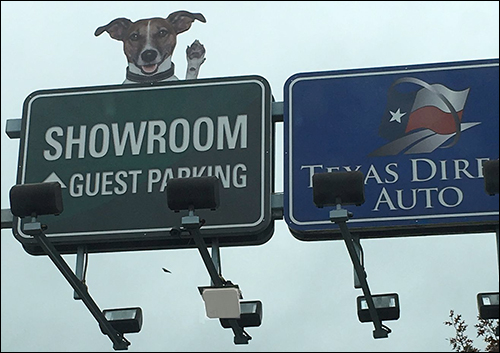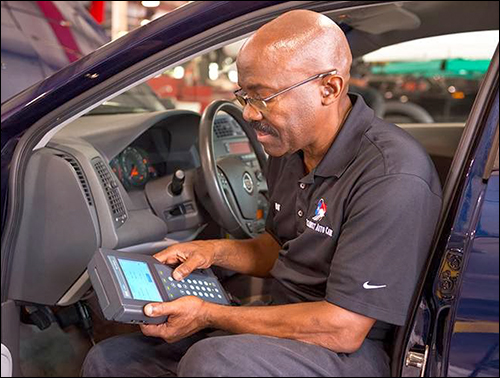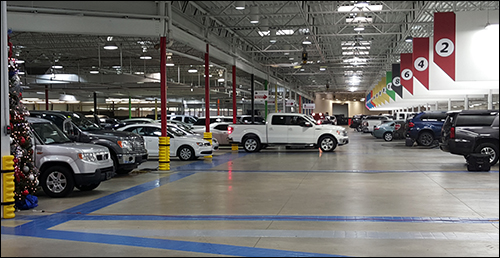Automotive seller Texas Direct Auto has boosted the throughput time of the 3,000 cars and trucks that pass through its facility each month by 30 percent, with the help of a radio frequency identification solution that tracks vehicles as they are received, maintained, test-driven, stored and permanently removed from the site by a buyer.
Texas Direct Auto, which was acquired last month by online car retailer Vroom, started as an Internet-only sales company approximately 13 years ago. The company sells trucks and cars out of its 70-acre campus in Stafford, Texas, and buyers purchase the vehicles online, as well as visiting the campus, test-driving the vehicles and making a purchase in the traditional manner. Texas Direct’s nationwide representatives examine 10,000 vehicles every month, but the company buys only about 3,000 of those, and sells about the same number. It also operates a 300,000-square-foot facility in which the vehicles are repaired and refurbished before being sold to customers.

Mike Welch, Texas Direct Auto’s cofounder, says he and his partner, Richard Williams, brought a technology background (with dot-com companies) to their startup, with the concept of a Web-based car sales system. “We’ve always approached the business with an eye on process and automation,” he states. For instance, Welch says, everything can be purchased online, or buyers can visit the facility and use a computer there to look up information about the cars and trucks for sale, as well as test-drive those vehicles. After making a purchase, a customer can view the car’s status as its final detailing is performed in preparation for pick-up, on an airport-like screen labeled “Departures.”
The RFID system began as a simple way to help employees and buyers quickly locate vehicles on the large lot. Because the company maintains so large an inventory within such a vast area, the company sought a system that would identify where each vehicle was located so that it could be easily accessed. In 2012, Texas Direct Auto first installed the RFID system, which it has expanded throughout the subsequent years, with the firm developing its own software and performing its own systems integration. (Welch declines to indicate the makes and models of RFID tags and readers that his company is currently using.)
At its 10 sites around the Houston area, workers apply an EPC ultrahigh-frequency (UHF) RFID tag to the windshield of each newly acquired vehicle. The tag’s unique ID number is linked to the vehicle identification number (VIN) in Texas Direct Auto’s software, which resides on its own database, as well as on a cloud-based server.
Upon arriving at the Texas lot, the car is checked into the 300,000-square-foot reconditioning facility, which uses the RFID system to track the vehicle during each step of the process. When a vehicle arrives at the facility’s entrance gate, an RFID reader captures its ID number, thereby prompting the gate to unlock and open, and updating the vehicle’s status as having arrived at the site.
Inside the reconditioning facility, an array of RFID readers (the company declines to indicate the exact number) has been installed. A single reader is installed at every repair station, work queue and photo booth (where pictures are taken for sales purposes).
As drivers arrive with cars and trucks, each vehicle proceeds to a queue for the appropriate repair station. An overhead reader installed at that queue captures the vehicle’s tag ID and updates the system regarding what line it is in.

Each repair station is dedicated to a specific task, such as painting and dent removal or parts repairs, and the station’s reader captures the tag ID, again updating the vehicle’s status. The system also displays data on a screen mounted at that location that indicates which services need to be provided to the car at the station, along with the next station to which the vehicle should be taken. Workers can also access the information via tablets or handheld computers.
The software collects all of this data, explains Jeremy Lorino, an engineer at Texas Direct Auto, and enables the company to run reports identifying bottlenecks or any other problems in the system.
When the car arrives at the exit gate, an RFID reader again interrogates its tag. The gate opens only if the software determines that all stations assigned to that vehicle have been visited.
Once the car has been refurbished, it is then moved to one of thousands of parking spots for storage. While RFID readers throughout the lot detect which zone a car is in, the driver texts that spot number to the company’s system, in order to pinpoint the location even further. A manual method alone, the company explains, would be prone to errors—for instance, the incorrect number being input in a text. Therefore, the RFID technology provides automated location information by zones. The firm has installed about 60 readers around the yard to read the tagged cars as they come within range. Each reader corresponds to a particular zone, so the RFID system does not provide the exact slot number where the vehicle is parked. However, it does provide the zone, which the company says is small enough that the car would be easily visible to the naked eye within that area.
To confirm that the information is correct, and to catch any tags that the fixed reader might have missed, workers drive an RFID-enabled cart around the yard each day. The cart has an onboard reader and antennas, as well as a tablet computer to display the collected read data. Cart drivers pass through the yard on a daily basis to visually check the inventory for flat tires or other problems, but with the RFID reader installed on board, Lorino says, they can also capture each car’s location data. Drivers use the tablet to input the zone they are entering as they travel around the yard, and each car’s tag ID is automatically captured. Zone names, such as Red G1 and Red G2, are indicated on signage around the campus, enabling drivers to know which zone to input. That data is transmitted back to Texas Direct Auto’s software via a Wi-Fi connection.
The location data can be made available to customers who use computers in the showroom, as well as to personnel seeking a specific vehicle. If a sales representative is already on the lot with a customer and wants to know the location of another vehicle, he or she can send a text message to the system, which will automatically send back that car’s location. Welch says the company considered enabling sales reps to access data directly from the software by using tablets, but those individuals said they prefer simply to send a text to the system requesting that information.

The company now also uses the technology to track when potential customers take vehicles off and back onto the lot for test-drives. The purpose of capturing this read data, according to the company, is a matter of customer service. The sales rep remains on the lot when the customer takes the vehicle out for a test drive, and links his or her own cell phone number in the system with that vehicle ID. Once the car comes back through the gate, the tag ID is read and the software forwards a text message to that salesperson’s phone, indicating that the customer has returned. In that way, the sales rep can greet the potential buyer quickly and find out how the test drive went.
The RFID system is also being used to quickly link to video footage in order to document situations when a vehicle is damaged or stolen. By knowing where the vehicle was located at any given time, the company can refer to the footage corresponding with that particular time and location. In this way, Welch says, multiple thefts and other incidents have been resolved and the cars have been recovered, since police were able to identify the perpetrators.
According to Welch, the company is still looking into other functions for the technology, though he declines to provide any details. He says his firm has not yet measured how much money the system saves, but he notes that it can lead to a sale that might not have been made if a vehicle hadn’t been found in a timely fashion while a customer was on the premises. “We know that by getting that level of organization, we can do more with the same resources,” he states—for instance, staff members spend less time searching for vehicles and more time helping customers.
With the technology, Welch reports, Texas Direct Auto has lowered its costs on several fronts. The system ensures that vehicles pass through its refurbishing facility more efficiently, while also reducing the number of workers required to locate cars on the campus.

